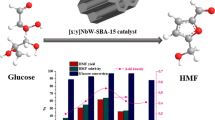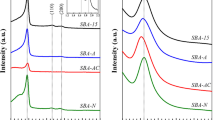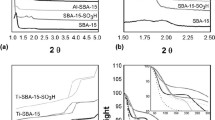Abstract
Different soft chemical syntheses were applied to synthesize eight Nb2O5 catalysts that were fully characterized in terms of structure, porosity, surface acidity and catalytic performance. The results showed that the catalysts indeed presented different structures and acidity. The distorted orthorhombic phase rendered solids with an improved porosity and allowed tuning higher concentrations of water-tolerant Lewis acid sites and higher Brønsted acidity when compared to a more crystalline pseudohexagonal phase. Catalysts holding the distorted orthorhombic structure were more active and selective to chemoconversion of trioses into lactic acid. It was shown though that product distribution was far more sensitive to changes in crystalline structure and Lewis acidity in the cascade reaction than the overall catalytic activity. A consistent linear correlation was found between lactic acid selectivity and the amount of water-tolerant Lewis acid sites, disclosing their dependence. It is the first time that such a clear correlation is demonstrated for triose upgrading cascade reaction.








Similar content being viewed by others
References
Pinxt HHCM, Kuster BFM, Marin GB (2000) Promoter effects in the Pt-catalysed oxidation of propylene glycol. Appl Catal A Gen 191:45–54. https://doi.org/10.1016/S0926-860X(99)00304-X
Zhang C, Wang T, Liu X, Ding Y (2016) Cu-promoted Pt/activated carbon catalyst for glycerol oxidation to lactic acid. J Mol Catal A Chem 424:91–97. https://doi.org/10.1016/j.molcata.2016.08.018
Clippel F, Dusselier M, Rompaey VR, Vanelderen P, Dijkmans J, Makshina E, Giebeler L, Oswald S, Baron GV, Denayer JFM, Pescarmona PP, Jacobs PA, Sels BF (2012) Fast and selective sugar conversion to alkyl lactate and lactic acid with bifunctional carbon–silica catalysts. J Am Chem Soc 134:10089–10101. https://doi.org/10.1021/ja301678w
Li L, Shen F, Smith RL, Qi X (2017) Quantitative chemocatalytic production of lactic acid from glucose under anaerobic conditions at room temperature. Green Chem 19:76–81. https://doi.org/10.1039/C6GC02443B
Paulino PN, Reis OC, Licea YE, Albuquerque EM, Fraga MA (2018) Valorisation of xylose to lactic acid on morphology-controlled ZnO catalysts. Catal Sci Technol 8:4945–4956. https://doi.org/10.1039/C8CY00679B
Dapsens PY, Mondelli C, Pérez-Ramírez J (2013) Highly selective Lewis acid sites in desilicated MFI zeolites for dihydroxyacetone isomerization to lactic acid. Chemsuschem 6:831–839. https://doi.org/10.1002/cssc.201200703
Lux S, Siebenhofer M (2013) Synthesis of lactic acid from dihydroxyacetone: use of alkaline-earth metal hydroxides. Catal Sci Technol 3:1380–1385. https://doi.org/10.1039/C3CY20859A
Holm MS, Saravanamurugan S, Taarning E (2010) Conversion of sugars to lactic acid derivatives using heterogeneous zeotype catalysts. Science 328:602–605. https://doi.org/10.1126/science.1183990
Duo J, Zhang Z, Yao G, Huo Z, Jin F (2016) Hydrothermal conversion of glucose into lactic acid with sodium silicate as a base catalyst. Catal Today 263:112–116. https://doi.org/10.1016/j.cattod.2015.11.007
(2020) Anuário estatístico brasileiro do petróleo, gás natural e biocombustíveis, Rio de Janeiro
(2019) Acompanhamento da safrabrasileira de Cana de Açúcar, Brasília
Dusselier M, Wouwe PV, Dewaele A, Makshina E, Sels BF (2013) Lactic acid as a platform chemical in the biobased economy: the role of chemocatalysis. Energy Environ Sci 6:1415–1442. https://doi.org/10.1039/C3EE00069A
Datta R, Henry M (2006) Lactic acid: recent advances in products, processes and technologies — a review. J Chem Technol Biotechnol 81:1119–1129. https://doi.org/10.1002/jctb.1486
Santos KMA, Albuquerque EM, Innocenti G, Borges LEP, Sievers C, Fraga MA (2019) The role of Brønsted and water-tolerant Lewis acid sites in the cascade aqueous-phase reaction of triose to lactic acid. ChemCatChem 11:3054–3063. https://doi.org/10.1002/cctc.201900519
Nakajima K, Hirata J, Kim M, Gupta NK, Murayama T, Yoshida A, Hiyoshi N, Fukuoka A, Ueda W (2018) Facile formation of lactic acid from a triose sugar in water over niobium oxide with a deformed orthorhombic phase. ACS Catal 8:283–290. https://doi.org/10.1021/acscatal.7b03003
Wang X, Song Y, Huang C, Wang B (2018) Crystalline niobium phosphates with water-tolerant and adjustable Lewis acid sites for the production of lactic acid from triose sugars. Sustain Energy Fuels 2:1530–1541. https://doi.org/10.1039/C8SE00140E
Innocenti G, Papadopoulos E, Fornasari G, Cavani F, Medford AJ, Sievers C (2020) Continuous liquid-phase upgrading of dihydroxyacetone to lactic acid over metal phosphate catalysts. ACS Catal 10:11936–11950. https://doi.org/10.1021/acscatal.0c03761
Wang X, Song Y, Huang L, Wang H, Huang C, Li C (2019) Tin modified Nb2O5 as an efficient solid acid catalyst for the catalytic conversion of triose sugars to lactic acid. Catal Sci Technol 9:1669–1679. https://doi.org/10.1039/C9CY00257J
Taarning E, Saravanamurugan S, Holm MS, Xiong J, West RM, Christensen CH (2009) Zeolite-catalyzed isomerization of triose sugars. Chemsuschem 2:625–627. https://doi.org/10.1002/cssc.200900099
West RM, Holm MS, Saravanamurugan S, Xiong J, Beversdorf Z, Taarning E, Christensen CH (2010) Zeolite H-USY for the production of lactic acid and methyl lactate from C3-sugars. J Catal 269:122–130. https://doi.org/10.1016/j.jcat.2009.10.023
Feliczak-Guzik A, Sprynskyy M, Nowak I, Buszewski B (2018) Catalytic isomerization of dihydroxyacetone to lactic acid and alkyl lactates over hierarchical zeolites containing tin. Catalysts 8:31–42. https://doi.org/10.3390/catal8010031
Feliczak-Guzik A, Sprynskyy M, Nowak I, Jaroniec M, Buszewski B (2018) Application of novel hierarchical niobium-containing zeolites for synthesis of alkyl lactate and lactic acid. J Colloid Interface Sci 516:379–383. https://doi.org/10.1016/j.jcis.2018.01.090
Pighin E, Díez VK, Di Cosimo JI (2017) Kinetic study of the ethyl lactate synthesis from triose sugars on Sn/Al2O3 catalysts. Catal Today 289:29–37. https://doi.org/10.1016/j.cattod.2016.10.002
Pighin EA, Di Cosimo JI, Díez VK (2018) Kinetic and mechanistic study of triose sugar conversion on Lewis and Brønsted acid solids. Mol Catal 458:189–197. https://doi.org/10.1016/J.MCAT.2017.11.026
Janssen KPF, Paul JS, Sels BF, Jacobs PA (2007) Glyoxylase biomimics: zeolite catalyzed conversion of trioses. Stud Surf Sci Catal 170:1222–1227. https://doi.org/10.1016/S0167-2991(07)80981-5
Pescarmona PP, Janssen KPF, Delaet C, Stroobants C, Houthoofd K, Philippaerts A, De Jonghe C, Paul JS, Jacobs PA, Sels BF (2010) Zeolite-catalysed conversion of C3 sugars to alkyl lactates. Green Chem 12:1083–1089. https://doi.org/10.1039/B921284A
Cho HJ, Dornath P, Fan W (2014) Synthesis of hierarchical Sn-MFI as Lewis acid catalysts for isomerization of cellulosic sugars. ACS Catal 4:2029–2037. https://doi.org/10.1021/cs500295u
Wang J, Masui Y, Onaka M (2011) Conversion of triose sugars with alcohols to alkyl lactates catalyzed by Brønsted acid tin ion-exchanged montmorillonite. Appl Catal B Environ 107:135–139. https://doi.org/10.1016/j.apcatb.2011.07.006
Mylin AM, Levytska SI, Sharanda ME, Brei VV (2014) Selective conversion of dihydroxyacetone–ethanol mixture into ethyl lactate over amphoteric ZrO2–TiO2 catalyst. Catal Commun 47:36–39. https://doi.org/10.1016/j.catcom.2014.01.004
Pighin E, Díez VK, Di Cosimo JI (2016) Synthesis of ethyl lactate from triose sugars on Sn/Al2O3 catalysts. Appl Catal A Gen 517:151–160. https://doi.org/10.1016/j.apcata.2016.03.007
Guo Q, Fan F, Pidko EA, van der Graaff WNP, Feng Z, Li C, Hensen EJM (2013) Highly active and recyclable Sn-MWW zeolite catalyst for sugar conversion to methyl lactate and lactic acid. Chemsuschem 6:1352–1356. https://doi.org/10.1002/cssc.201300160
Li L, Stroobants C, Lin K, Jacobs PA, Sels BF, Pescarmona PP (2011) Selective conversion of trioses to lactates over Lewis acid heterogeneous catalysts. Green Chem 13:1175–1181. https://doi.org/10.1039/C0GC00923G
Wang X, Liang F, Huang C, Li Y, Chen B (2015) Highly active tin (IV) phosphate phase transfer catalysts for the production of lactic acid from triose sugars. Catal Sci Technol 5:4410–4421. https://doi.org/10.1039/C5CY00647C
Nakajima K, Fukui T, Kato H, Kitano M, Kondo JN, Hayashi S, Hara M (2010) Structure and acid catalysis of mesoporous Nb2O5·nH2O. Chem Mater 22:3332–3339. https://doi.org/10.1021/cm100391q
Carniti P, Gervasini A, Bossola F, Dal Santo V (2016) Cooperative action of Brønsted and Lewis acid sites of niobium phosphate catalysts for cellobiose conversion in water. Appl Catal B Environ 193:93–102. https://doi.org/10.1016/j.apcatb.2016.04.012
Gervasini A, Carniti P, Marzo M, Auroux A (2012) Effect of the K+, Ba2+, and Nd3+ addition to Nb2O5 on intrinsic and effective acidity in relation to biomass reactions. J Catal 296:143–155. https://doi.org/10.1016/j.jcat.2012.09.014
Nakajima K, Baba Y, Noma R, Kitano M, Kondo JN, Hayashi S, Hara M (2011) Nb2O5·nH2O as a heterogeneous catalyst with water-tolerant Lewis acid sites. J Am Chem Soc 133:4224–4227. https://doi.org/10.1021/ja110482r
Catrinck MN, Ribeiro ES, Monteiro RS, Ribas RM, Barbosa MHP, Teófilo RF (2017) Direct conversion of glucose to 5-hydroxymethylfurfural using a mixture of niobic acid and niobium phosphate as a solid acid catalyst. Fuel 210:67–74. https://doi.org/10.1016/j.fuel.2017.08.035
Marzo M, Gervasini A, Carniti P (2012) Improving stability of Nb2O5 catalyst in fructose dehydration reaction in water solvent by ion-doping. Catal Today 192:89–95. https://doi.org/10.1016/j.cattod.2011.12.014
Gupta NK, Fukuoka A, Nakajima K (2017) Amorphous Nb2O5 as a selective and reusable catalyst for furfural production from xylose in biphasic water and toluene. ACS Catal 7:2430–2436. https://doi.org/10.1021/acscatal.6b03682
García-Sancho C, Rubio-Caballero JM, Mérida-Robles JM, Moreno-Tost R, Santamaría-González J, Maireles-Torres P (2014) Mesoporous Nb2O5 as solid acid catalyst for dehydration of d-xylose into furfural. Catal Today 234:119–124. https://doi.org/10.1016/j.cattod.2014.02.012
Santos KMA, Albuquerque EM, Borges LEP, Fraga MA (2018) Discussing Lewis and Brønsted acidity on continuous pyruvaldehyde Cannizzaro reaction to lactic acid over solid catalysts. Mol Catal 458:198–205. https://doi.org/10.1016/j.mcat.2017.12.010
Skrodczky K, Antunes MM, Han X, Santangelo S, Scholz G, Valente AA, Pinna N, Russo PA (2019) Niobium pentoxide nanomaterials with distorted structures as efficient acid catalysts. Commun Chem 2:129–139. https://doi.org/10.1038/s42004-019-0231-3
Chan X, Pu T, Chen X, James A, Lee J, Parise JB, Kim DH, Kim T (2017) Effect of niobium oxide phase on the furfuryl alcohol dehydration. Catal Commun 97:65–69. https://doi.org/10.1016/j.catcom.2017.04.019
Leite ER, Vila C, Bettini J, Longo E (2006) Synthesis of niobia nanocrystals with controlled morphology. J Phys Chem B 110:18088–18090. https://doi.org/10.1021/jp0642544
Lopes OF, Paris EC, Ribeiro C (2014) Synthesis of Nb2O5 nanoparticles through the oxidant peroxide method applied to organic pollutant photodegradation: a mechanistic study. Appl Catal B Environ 144:800–808. https://doi.org/10.1016/j.apcatb.2013.08.031
Murayama T, Chen J, Hirata J, Matsumoto K, Ueda W (2014) Hydrothermal synthesis of octahedra-based layered niobium oxide and its catalytic activity as a solid acid. Catal Sci Technol 4:4250–4257. https://doi.org/10.1039/C4CY00713A
Albuquerque EM, Borges LEP, Fraga MA, Sievers C (2017) Relationship between acid–base properties and the activity of ZrO2-based catalysts for the Cannizzaro reaction of pyruvaldehyde to lactic acid. ChemCatChem 9:2675–2683. https://doi.org/10.1002/cctc.201700305
Coelho TL, Marinho B, Albuquerque EM, Fraga MA (2020) Discussing the performance of beta zeolites in aqueous-phase valorization of xylose. Catal Sci Technol 10:7165–7176. https://doi.org/10.1039/D0CY01176B
Emeis CA (1993) Determination of integrated molar extinction coefficients for infrared absorption bands of pyridine adsorbed on solid acid catalysts. J Catal 141:347–354. https://doi.org/10.1006/jcat.1993.1145
Baertsch CD, Komala KT, Chua YH, Iglesia E (2002) Genesis of Brønsted acid sites during dehydration of 2-butanol on tungsten oxide catalysts. J Catal 205:44–57. https://doi.org/10.1006/jcat.2001.3426
Herval LKS, von Dreifus D, Rabelo AC, Rodrigues AD, Pereira EC, Gobato YG, Oliveira AJA, Godoy MPF (2015) The role of defects on the structural and magnetic properties of Nb2O5. J Alloys Compd 653:358–362. https://doi.org/10.1016/j.jallcom.2015.09.019
Murayama T, Ueda W, Haruta M (2016) Deposition of gold nanoparticles on niobium pentoxide with different crystal structures for room-temperature carbon monoxide oxidation. ChemCatChem 8:2620–2624. https://doi.org/10.1002/cctc.201600563
Onfroy T, Clet G, Houalla M (2005) Correlations between acidity, surface structure, and catalytic activity of niobium oxide supported on zirconia. J Phys Chem B 109:14588–14594. https://doi.org/10.1021/jp0517347
Menezes AO, Silva PS, Padrón Hernández E, Borges LEP, Fraga MA (2010) Tuning surface basic properties of nanocrystalline MgO by controlling the preparation conditions. Langmuir 26:3382–3387. https://doi.org/10.1021/la903149y
Nowak I, Ziolek M (1999) Niobium compounds: preparation, characterization, and application in heterogeneous catalysis. Chem Rev 99:3603–3624. https://doi.org/10.1021/cr9800208
Li S, Xu Q, Uchaker E, Cao X, Cao G (2016) Comparison of amorphous, pseudohexagonal and orthorhombic Nb2O5 for high-rate lithium ion insertion. CrystEngComm. 18:2532–2540. https://doi.org/10.1039/C5CE02069G
Copeland JR, Shi X-R, Sholl DS, Sievers C (2013) Surface interactions of C2 and C3 polyols with γ-Al2O3 and the role of coadsorbed water. Langmuir 29:581–593. https://doi.org/10.1021/la304074x
Xin Y, Dong L, Guo Y, Liu X, Hu Y, Wang Y (2019) Correlation of the catalytic performance with Nb2O5 surface properties in the hydrodeoxygenation of lignin model compound. J Catal 375:202–212. https://doi.org/10.1016/j.jcat.2019.05.007
Kobayashi Y, Hata H, Salama M, Mallouk TE (2007) Scrolled sheet precursor route to niobium and tantalum oxide nanotubes. Nano Lett 7:2142–2145. https://doi.org/10.1021/nl0708260
Tanabe K (2003) Catalytic application of niobium compounds. Catal Today 78:65–77. https://doi.org/10.1016/S0920-5861(02)00343-7
Ziolek M, Sobczak I (2017) The role of niobium component in heterogeneous catalysts. Catal Today 285:211–225. https://doi.org/10.1016/j.cattod.2016.12.013
Ushikubo T (2000) Recent topics of research and development of catalysis by niobium and tantalum oxides. Catal Today 57:331–338. https://doi.org/10.1016/S0920-5861(99)00344-2
Zhao Y, Eley C, Hu J, Foord JS, Ye L, He H, Tsang SCE (2012) Shape-dependent acidity and photocatalytic activity of nb2o5 nanocrystals with an active TT (001) surface. Angew Chemie Int Ed 51:3846–3849. https://doi.org/10.1002/anie.201108580
Jehng J-M, Wachs IE (1990) The molecular structures and reactivity of supported niobium oxide catalysts. Catal Today 8:37–55. https://doi.org/10.1021/j100172a049
Kreissl HT, Li MMJ, Peng Y-K, Nakagawa K, Hooper TJN, Hanna JV, Shepherd A, Wu T-S, Soo Y-L, Tsang SCE (2017) Structural studies of bulk to nanosize niobium oxides with correlation to their acidity. J Am Chem Soc 139:12670–12680. https://doi.org/10.1021/jacs.7b06856
Chu Y, Yu Z, Zheng A, Fang H, Zhang H, Huang S-J, Liu S-B, Deng F (2011) Acidic strengths of Brønsted and Lewis acid sites in solid acids scaled by 31P NMR chemical shifts of adsorbed trimethylphosphine. J Phys Chem C 115:7660–7667. https://doi.org/10.1021/jp200811b
Takagaki A, Tagusagawa C, Hayashi S, Hara M, Domen K (2010) Nanosheets as highly active solid acid catalysts for green chemical syntheses. Energy Environ Sci 3:82–93. https://doi.org/10.1039/B918563A
Choudhary V, Sandler SI, Vlachos DG (2012) Conversion of xylose to furfural using Lewis and Brønsted acid catalysts in aqueous media. ACS Catal 2:2022–2028. https://doi.org/10.1021/cs300265d
Liu H, Bayat N, Iglesia E (2003) Site titration with organic bases during catalysis: selectivity modifier and structural probe in methanol oxidation on Keggin clusters. Angew Chemie Int Ed 42:5072–5075. https://doi.org/10.1002/ange.200352393
Sullivan MM, Held JT, Bhan A (2015) Structure and site evolution of molybdenum carbide catalysts upon exposure to oxygen. J Catal 326:82–91. https://doi.org/10.1016/j.jcat.2015.03.011
Macht J, Baertsch CD, May-Lozano M, Soled SL, Wang Y, Iglesia E (2004) Support effects on Brønsted acid site densities and alcohol dehydration turnover rates on tungsten oxide domains. J Catal 227:479–491. https://doi.org/10.1016/j.jcat.2004.08.014
Gounder R, Jones AJ, Carr RT, Iglesia E (2012) Solvation and acid strength effects on catalysis by faujasite zeolites. J Catal 286:214–223. https://doi.org/10.1016/j.jcat.2011.11.002
Yang L, Su J, Carl S, Lynam JG, Yang X, Lin H (2015) Catalytic conversion of hemicellulosic biomass to lactic acid in pH neutral aqueous phase media. Appl Catal B Environ 162:149–157. https://doi.org/10.1016/j.apcatb.2014.06.025
Acknowledgements
The authors thank Laboratório Multi-Usuário de Raios X at Instituto de Química, UFRJ, for XRD measurements. CBMM is acknowledged for kindly supplying both the commercial niobic acid and ammonium niobium oxalate.
Funding
The authors acknowledge the financial support from CNPq (Proc. 427639/2018–2; Proc. 308146/2019–0) and FAPERJ (E-26/202.660/2019).
Author information
Authors and Affiliations
Corresponding author
Ethics declarations
Conflict of interest
The authors declare no competing interests.
Additional information
Publisher's note
Springer Nature remains neutral with regard to jurisdictional claims in published maps and institutional affiliations.
Supplementary Information
Below is the link to the electronic supplementary material.
Rights and permissions
About this article
Cite this article
Santos, K.M.A., Albuquerque, E.M., Coelho, T.L. et al. Continuous aqueous-phase cascade conversion of trioses to lactic acid over Nb2O5 catalysts. Biomass Conv. Bioref. 13, 11865–11878 (2023). https://doi.org/10.1007/s13399-021-02121-5
Received:
Revised:
Accepted:
Published:
Issue Date:
DOI: https://doi.org/10.1007/s13399-021-02121-5




